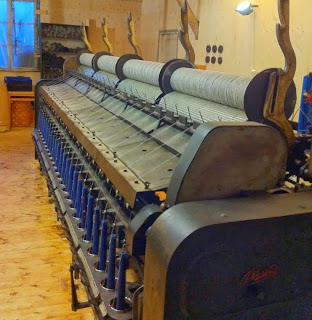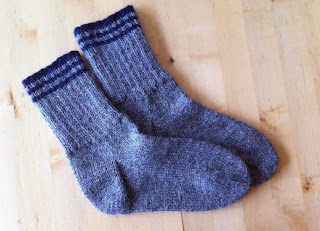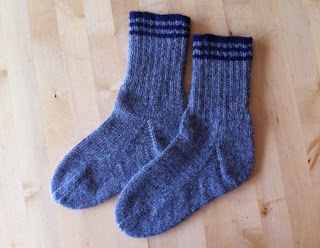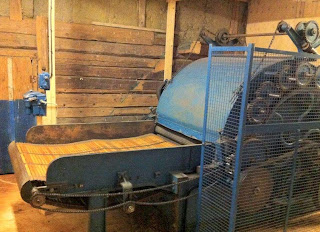torsdag 31 oktober 2013
Socks in 100% wool - a 4-ply knitting yarn from Rauma that feels promising
I have for a very long time been in search of a 100% wool sock yarn. When I grew up my mother knitted socks for the whole family using a rather coarse yarn. The socks were called ragg socks and we used them all winter in our shoes as well as at home. Originally ragg socks were knitted with yarn where the wool, when spun, was mixed with fibres from goat to make it really strong. I don´t think that that was what my mother used, I have no information regarding the mix of her yarn. But I am pretty sure that it was 100% wool.
This is the "Rauma 4 tr. Strikkegarn" (4-ply knitting yarn) made of 100% wool from the Spelsau breed. It is coarser than most yarns and it is supposed to be very strong and well suited for socks. In other words: it feels great!
The Spelsau sheep (also called Spaelsau, Villsau or Old Norwegean) almost died out in the twentieth century. Sheep resembling the Spelsau have been around for about three thousand years - amazing! Nowadays a "modern" Spelsau also include genes from other breeds such as Icelandic, Faroese or Finn sheep. It has two coats: the undercoat is quite fine and the outercoat is much coarser and twice as long as the undercoat. This Rauma yarn feels as if they have used fiberes from the outercoat in the yarn to make it strong. It also has a nice lustre, probably due to the long strong fibres from the outercoat.
Socks are finished. I will use them this winter to see if the yarn is as strong as I hope.
söndag 13 oktober 2013
A visit to Solkustens Spinnverkstad
Today we visited Solkustens Spinnverkstad together with some friends. Solkusten is a small mill in Roslagen that spins yarn from Swedish wool.
We had booked a tour and we were guided by Ingrid. Ingrid is one of the owners and she told us about the mills history, the move to Roslagen and the wool used for different yarns.
We were also shown the machines and guided through the process of making yarn, from the sorting of the wool to the finished product.
The machines are old, but still going strong. One advantage with these machines is that they are gentle on the wool while processing it. This means that the finish of the yarn will be more lustrous and the wool fibres are damaged less during the process.
After the tour we visited the shop, I have rarely seen a a more picturesque shop - really inspiring!
Adding to the stash was a perfect end of our visit. If you want to read more about the mill you can visit their home page here. Their information brochure (Swedish and English) is found here.
We had booked a tour and we were guided by Ingrid. Ingrid is one of the owners and she told us about the mills history, the move to Roslagen and the wool used for different yarns.
We were also shown the machines and guided through the process of making yarn, from the sorting of the wool to the finished product.
The machines are old, but still going strong. One advantage with these machines is that they are gentle on the wool while processing it. This means that the finish of the yarn will be more lustrous and the wool fibres are damaged less during the process.
 | ||||
| The carding machine |
 |
| The spinning machine |
 |
| The plying machine |
Adding to the stash was a perfect end of our visit. If you want to read more about the mill you can visit their home page here. Their information brochure (Swedish and English) is found here.
Etiketter:
yarn / garn
lördag 12 oktober 2013
Bandweaving - New start
It is now a year and a half since I took a band weaving class at Sätergläntan. A couple of weeks after the class I tried weaving at home, but got very frustrated with my poor result.
I do know that there is no "quick fix" when learning new skills - but sometimes there is just not enough patience available.
These last weeks I have been thinking about making a new try. I bought a yarn better suited for band weaving than the ones that I used a year ago. I searched through our "wool/yarn room" to find the necessary tools and started to warp the yarn.
I even spent a couple of hours weaving. It felt much better than the previous attempts a year ago.
I chose a simple pattern from the Sami-tradition. I have to start with something that is not complicated so that I can focus on the basics of the weaving. I especially like the colours - so typical for the Sami bands.
Autumn has come and today was a beautiful day. We took a walk to the Iron Age burial site nearby.
I do know that there is no "quick fix" when learning new skills - but sometimes there is just not enough patience available.
These last weeks I have been thinking about making a new try. I bought a yarn better suited for band weaving than the ones that I used a year ago. I searched through our "wool/yarn room" to find the necessary tools and started to warp the yarn.
I even spent a couple of hours weaving. It felt much better than the previous attempts a year ago.
I chose a simple pattern from the Sami-tradition. I have to start with something that is not complicated so that I can focus on the basics of the weaving. I especially like the colours - so typical for the Sami bands.
Autumn has come and today was a beautiful day. We took a walk to the Iron Age burial site nearby.
Prenumerera på:
Inlägg (Atom)
















